Digital Poster
Connectivity & Tractography
ISMRM & ISMRT Annual Meeting & Exhibition • 03-08 June 2023 • Toronto, ON, Canada

| Computer # | |||
|---|---|---|---|
3019.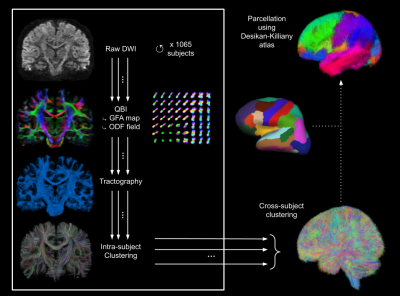 |
141 |
A novel atlas of the superficial white matter connectivity based
on the whole HCP cohort - an inter-individual variability study.
Bastien Herlin1,2,3,
Ivy Uszynski1,
Maëlig Chauvel1,
Sophie Dupont2,3,
and Cyril Poupon1
1BAOBAB, NeuroSpin, Université Paris-Saclay, CNRS, CEA, Gif-sur-Yvette, France, 2AP-HP, Epilepsy Unit, GH Pitié-Salpêtrière-Charles Foix, Paris, France, 3Sorbonne Université, Paris, France Keywords: White Matter, Brain Connectivity Superficial white matter (SWM) tracts exhibit a high cross-subject variability, which makes them difficult to study. We used the whole HCP cohort, which included 1065 subjects, to build a comprehensive atlas of the short-range cortico-cortical connections using an advanced diffusion analysis and tractography pipeline, followed by an individual and a group-level fiber clustering. Furthermore, we measured the percentage of occurrence of each cluster within the population. In addition to enabling the automatic labeling of any new subject’s SWM tracts, our atlas paves the way for a thorough cross-subject variability study of superficial connectivity. |
|
3020.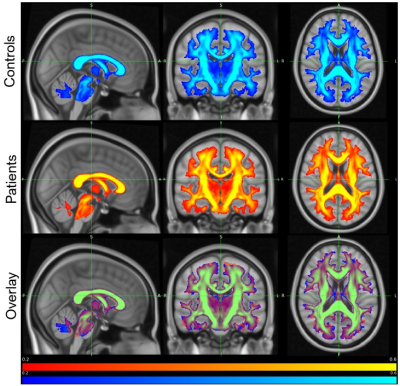 |
142 |
Patients with sickle cell disease have altered brain fractional
anisotropy, axial, mean and radial diffusivity quantified by 7T
MRI.
Elizabeth Meinert-Spyker1,
Tales Santini2,
Sharadhi Umesh Bharadwaj1,
Enrico Novelli3,4,5,
Tamer Ibrahim2,6,7,
and Sossena Wood1,8
1Biomedical Engineering, Carnegie Mellon University, Pittsburgh, PA, United States, 2Bioengineering, University of Pittsburgh, Pittsburgh, PA, United States, 3Hematology/Oncology, University of Pittsburgh, Pittsburgh, PA, United States, 4Pittsburgh Heart, Lung and Blood Vascular Medicine Institute, University of Pittsburgh, Pittsburgh, PA, United States, 5Sickle Cell Center of Excellence, University of Pittsburgh, Pittsburgh, PA, United States, 6Radiology, University of Pittsburgh, Pittsburgh, PA, United States, 7Psychiatry, University of Pittsburgh, Pittsburgh, PA, United States, 8Neuroscience Institute, Carnegie Mellon University, Pittsburgh, PA, United States Keywords: White Matter, Diffusion Tensor Imaging, Sickle cell disease This abstract compares diffusion tensor imaging parameters between healthy controls and sickle cell disease (SCD) patients. Various softwares were utilized to obtain diffusion metrics and conduct voxelwise comparison was conducted. Fractional anisotropy (FA) and axial diffusivity (AD) values were significantly decreased in patients with SCD compared to controls, while mean diffusivity (MD) and radial diffusivity (RD) were primarily increased in patients compared to controls. Our FA and MD findings are consistent with other studies comparing diffusion metrics of individuals with SCD at a lower magnet field. We also present novel findings comparing AD and RD values for the SCD population. |
|
3021.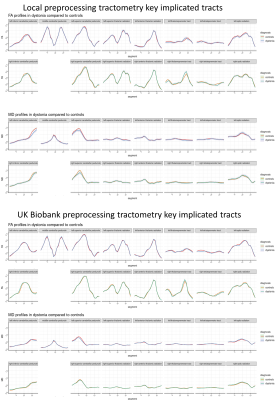 |
143 |
Diffusion MRI tractometry findings in Dystonia: a UK Biobank
Study
Claire L. MacIver1,2,
Chantal M.W. Tax2,3,
Derek K Jones2,
Ann-Kathrin Schalkamp4,
Cynthia Sandor4,
Grace Bailey5,
Megan Wadon5,
and Kathryn J Peall5
1Neuroscience and Mental Health Research Institute,, Cardiff University, Cardiff, United Kingdom, 2Cardiff University Brain Imaging Centre, Cardiff University, Cardiff, United Kingdom, 33Image Sciences Institute, University Medical Centre Utrect, Utrect, Netherlands, 4UK Dementia Research Institute, Cardiff University, Cardiff, United Kingdom, 5Neuroscience and Mental Health Research Institute, Cardiff University, Cardiff, United Kingdom Keywords: White Matter, Diffusion/other diffusion imaging techniques, movement disorders Dystonia is a hyperkinetic disorder involving uncontrolled muscle contractions. Brain motor networks have been implicated, with heterogenous methodology and findings in the existing diffusion MRI literature. We compared diffusion findings in white matter motor pathways in dystonia (n=76) and healthy controls (n=311) derived from the UK biobank, assessing differing preprocessing and analysis approaches. An in-house pipeline identified localised tractometry MD and kurtosis differences in cerebellar peduncles, thalamic radiations and thalamo-premotor tracts in dystonia, findings not replicated using differing analysis and preprocessing approaches. Overall, localised white matter differences are implicated in dystonia, with the impact of methodology on group-level findings highlighted. |
|
3022.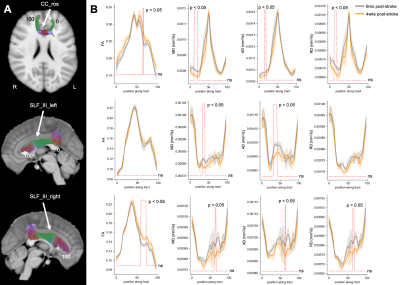 |
144 |
Evidence of diffusion tensor imaging measures of white matter
microstructure changes within six months after stroke
Stefan E. Poirier1,2,
Jonathan D. Thiessen1,2,
Alexander V. Khaw1,3,
and Udunna C. Anazodo1,2,3,4
1Lawson Imaging, Lawson Health Research Institute, London, ON, Canada, 2Department of Medical Biophysics, Western University, London, ON, Canada, 3Department of Clinical Neurological Sciences, Western University, London, ON, Canada, 4Department of Neurology and Neurosurgery, McGill University, Montréal, QC, Canada Keywords: White Matter, Diffusion Tensor Imaging White matter (WM) damage is associated with post-stroke cognitive impairment. In this study, we used diffusion tensor imaging (DTI) to investigate changes in WM microstructure in patients within 6-months following stroke. Quantitative DTI measurements were compared in patients at 6-months relative to 4-weeks post-stroke. DTI showed signs of reduced WM integrity in several WM tracts, including rostrum of corpus callosum and superior longitudinal fasciculus III in patients 6-months post-stroke. In elderly adults, WM microstructure can be disrupted following ischemic stroke. These findings motivate larger population stroke studies using advanced diffusion MRI techniques to further assess WM structure in stroke patients. |
|
3023.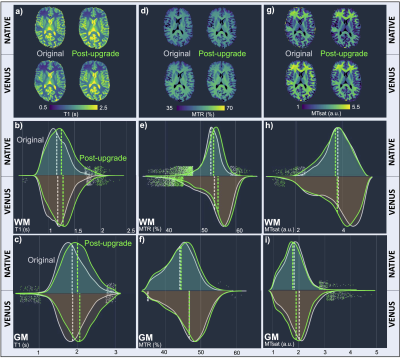 |
145 |
Vendor-neutrality and upgrade immunity: Post-upgrade assessment
of vendor-neutral qMRI from two perspectives
Agah Karakuzu1,2,
Paule Samson 2,
and Nikola Stikov1,2,3
1NeuroPoly Lab, Polytechnique Montreal, Montreal, QC, Canada, 2Montreal Heart Institute, University of Montreal, Montreal, QC, Canada, 3Center for Advanced Interdisciplinary Research, Ss. Cyril and Methodius University, Skopje, Macedonia Keywords: White Matter, Quantitative Imaging, vendor-neutral, post-upgrade, T1, MTR, MTsat We scanned the ISMRM/NIST system phantom and one healthy participant to compare vendor-neutral and vendor-native T1, MTR and MTsat maps pre- and post-upgrade. Our findings indicate a systematic T1 bias in the phantom (up to 18.5%) that is linked to post-upgrade prescan calibrations. In-vivo, MTR remains stable, whereas the T1 bias (up to 9%) affects MTsat more. On the other hand, end-to-end consistency of the vendor-neutral workflow is immune against the software upgrade (e.g., data was consistently exported in the BIDS format). To disentangle the effect of upgrades on longitudinal stability, qMRI would benefit from transparent vendor-neutral prescan calibrations. |
|
3024.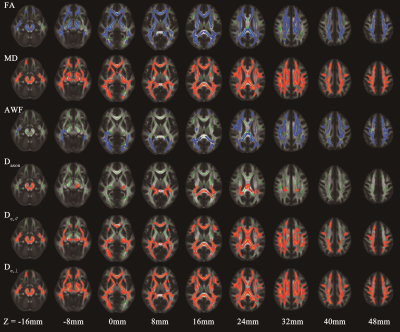 |
146 |
White matter tract integrity metrics sensitive to white matter
microstructural changes and cognitive performance in type 2
diabetic patients
Jie Gao1,
Dongsheng Zhang1,
Xuejiao Yan1,
Min Tang1,
Xin Zhang1,
Kai Ai2,
Xiaoyan Lei1,
and Xiaoling Zhang1
1Shaanxi Provincial People’s Hospital, Xi’an, China, 2Philips Healthcare, Xi’an, China Keywords: White Matter, Diabetes This study aims to use white matter tract integrity (WMTI) model based on DKI to explore white matter alternations in T2DM. DTI and WMTI metrics were compared between 73 T2DM patients and 57 HCs. The widespread increased extra-axonal diffusivity with limited increased intra-axonal diffusivity in T2DM reflected different degrees of axonal edema, vasogenic edema and/or demyelination. De,⊥ (radial extra-axonal diffusivity) was demonstrated to be the most sensitive parameter in detecting the white matter microstructural changes. De,⊥ in genu of the corpus callosum was correlated with attention performance, which is expected to be a imaging marker reflecting cognitive impairment in T2DM. |
|
3025.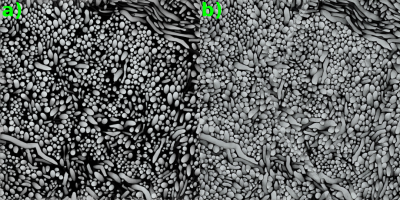 |
147 |
A step forward to improve large numerical phantoms at the
microstructure level using CACTUS
Juan Luis Villarreal Haro1,
Remy Marc Gardier1,
Erick Jorge Canales-Rodríguez1,
Gabriel Girard1,2,
Jean-Philippe Thiran1,3,4,
and Jonathan Rafael Patino1,4
1Signal Processing Laboratory (LTS5), École polytechnique fédérale de Lausanne, Lausanne, Switzerland, 2Department of Computer Science, Université de Sherbrooke, Monreal, QC, Canada, 3Radiology Department, Centre Hospitalier Universitaire Vaudois and University of Lausanne, Lausanne, Switzerland, 4CIBM Center for Biomedical Imaging, Lausanne, Switzerland Keywords: White Matter, Phantoms, Monte Carlo simulations for microstructure in DW-MRI Inferring microscopic tissue properties from the measured signal is one of the main objectives of diffusion-weighted magnetic resonance imaging. The use of Monte-Carlo Simulations for DW-MRI on realistic substrates will help the study of DWI-MRI signals in controlled environments and investigate, extract, and validate approaches for the understanding of white matter features. This work provides a unique framework for building complex white matter phantoms with novel properties, such as 1) substrates with a high packing density of 95% intra-axonal volume percentage and substrate sizes of (500 um)3, 2) Create, generalise, extend, and preexisting phantom configurations used by other studies. |
|
3026.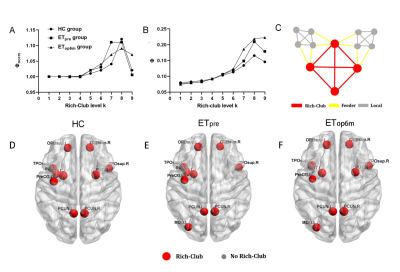 |
148 |
Alterations of white matter connectivity in essential tremor
with MR-guided focused ultrasound thalamotomy
Xiaoyu Wang1,2 and
Xin Lou1
1Department of Radiology, Chinese PLA General Hospital, Beijing, China, 2Nankai University, Tianjing, China Keywords: White Matter, Treatment, MRgFUS This is important research to assess the effects of MRgFUS thalamotomy on white matter connectivity in ET. Results showed that MRgFUS might act the topologic properties on brain networks. Rich-club and small-world organizations exist in HC and ET. The right orbital part of the superior frontal gyrus and right putamen were identified as a hub in the ET group only, whereas the left putamen identified as hubs in the group only. Importantly, gamma and sigma correlated tremor improvement after MRgFUS thalamotomy, playing a role in reflecting tremor improvement for clinical treatment. |
|
3027. |
149 |
Sex-specific differences of the number of fiber orientations
(NuFO) in the human brain
Szabolcs David1,
Alexander Leemans1,
and Alberto de Luca1
1UMC Utrecht, Utrecht, Netherlands Keywords: White Matter, Brain, crossing fibers, biomarker, NuFO, FA Diffusion MRI-based biomarkers are commonly used to assess brain microstructural properties. Mathematical models have been developed to calculate various metrics; each are sensitive to different tissue features. Here, we investigate whether there are differences in the number of fiber orientations (NuFO) between male and female brains and how these results compare to corresponding DTI-derived fractional anisotropy (FA) findings. Results show NuFO-based differences with high effect size (>1 Cohen’s D) in hippocampi, which are undetected in FA-tests. Therefore, NuFO could provide complementary aspects to DTI metrics to capture differences in microstructural organization. |
|
3028.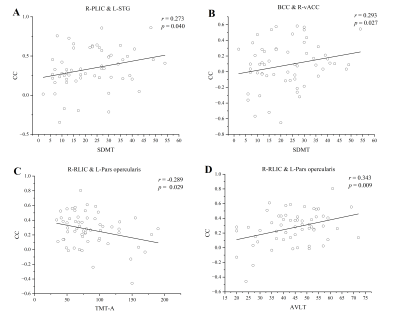 |
150 |
Abnormal functional connectivity between white and gray matter
is associated with hearing loss and cognitive dysfunction in
presbycusis
Yao Wang1,
Yuting Gao1,
Yu Han1,
Xiao Li2,
Fengyi Wang1,
Fuxin Ren2,
Weibo Chen3,
Muwei Li4,
and Fei Gao2
1School of Life Sciences, Tiangong University, Tianjin, China, 2Department of Radiology, Shandong Provincial Hospital Affiliated to Shandong First Medical University, Jinan, China, 3Philips Healthcare, Shanghai, China, 4Vanderbilt University Institute of Imaging Science, Nashville, TN, United States Keywords: White Matter, Aging Presbycusis is characterized by high-frequency hearing loss and is closely related to cognitive decline. In this study, we aimed to explore the connectivity changes of WM and GM in the brains of presbycusis patients and their relationship with cognitive impairment and hearing loss. The results of this study indicated that the functional connectivity of WM and GM was abnormal in presbycusis patients, mainly in the PLIC, BCC, STG, par opercularis, etc. These changes might be associated with auditory processing and cognitive compensation. This study may provide new insights into the underlying neural mechanisms between presbycusis and cognitive impairment. |
|
3029.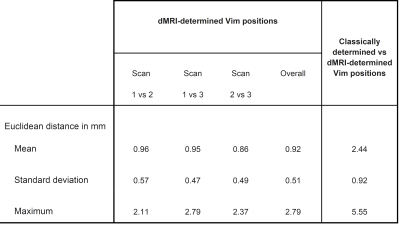 |
151 |
A test-retest analysis for ventral intermediate nucleus
localization with CSD tractography for deep brain stimulation.
Benjamin Verhaaren1,
Ahmed Radwan2,3,
Ronald Peeters1,
Alexandra Boogers4,
Jana Peeters3,
Wim Vandenberghe3,4,
Philippe De Vloo3,5,
Bart Nuttin3,5,
and Stefan Sunaert1,2,3
1Radiology, University Hospitals Leuven, Leuven, Belgium, 2Imaging and Pathology, KU Leuven, Leuven, Belgium, 3Neurosciences, KU Leuven, Leuven, Belgium, 4Neurology, University Hospitals Leuven, Leuven, Belgium, 5Neurosurgery, University Hospitals Leuven, Leuven, Belgium Keywords: White Matter, Diffusion Tensor Imaging, Deep brain stimulation We found that the location of the ventral intermediate nucleus (Vim) as determined with dMRI tractography differed only 0.92 mm on average on subsequent scans within the same individual (SD: 0.51 mm) in a test-retest study of 29 healthy individuals. The difference with a commonly used manual method that locates the Vim at fixed distances in relation to the commissures and third ventricular wall was more pronounced: on average 2.44 mm (SD: 0.92 mm). We believe that dMRI tractography based DBS target determination seems feasible and rather accurate, given that acquisition parameters and post-processing are optimal. |
|
3030.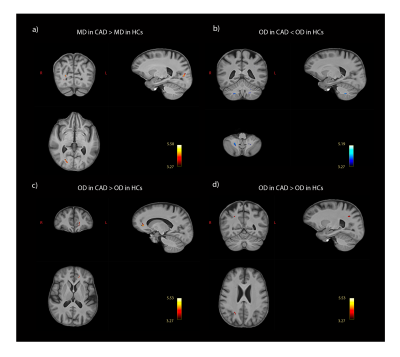 |
152 |
Differences in cerebellar fiber tract dispersion in coronary
artery disease patients are associated with episodic memory and
processing speed
Stefanie A Tremblay1,2,3,
Dalia Sabra1,2,3,4,
Safa Sanami1,2,
Ali Rezaei1,2,
Zacharie Potvin-Jutras1,2,
Christine Gagnon2,
Brittany Intzandt5,
Amélie Mainville-Berthiaume6,
Lindsay N Wright1,2,
Dajana Vuckovic7,
Josep Iglesies-Grau2,8,
Thomas Vincent2,
Mathieu Gayda2,
Anil Nigam2,
Louis Bherer2,8,9,
and Claudine J Gauthier1,2,3
1Physics, Concordia University, Montreal, QC, Canada, 2Centre ÉPIC and Research Center, Montreal Heart Institute, Montreal, QC, Canada, 3PERFORM Centre, Concordia University, Montreal, QC, Canada, 4Department of Biomedical Science, Université de Montreal, Montreal, QC, Canada, 5BrainLab, Hurvitz Brain Sciences Program, Sunnybrook Research Institute, Toronto, ON, Canada, 6Psychology, Concordia University, Montreal, QC, Canada, 7Department of Chemistry and Biochemistry, Concordia University, Montreal, QC, Canada, 8Department of Medicine, Université de Montreal, Montreal, QC, Canada, 9Research Center, Institut Universitaire de Gériatrie de Montréal, Montreal, QC, Canada Keywords: White Matter, Diffusion/other diffusion imaging techniques, DTI, NODDI Here we characterized the impact of coronary artery disease (CAD) on the brain’s white matter (WM) using diffusion tensor (DTI) and neurite orientation dispersion and density imaging (NODDI). Mean diffusivity was higher in CAD patients in occipital WM and there were differences in orientation dispersion in several tracts between CAD patients and healthy controls. Alterations in fiber dispersion of cerebellar WM were associated with global cognition, episodic memory, and processing speed. Our study supports the use of advanced diffusion imaging models for the early detection of subtle WM damage in populations at risk of developing dementia such as CAD patients. |
|
3031.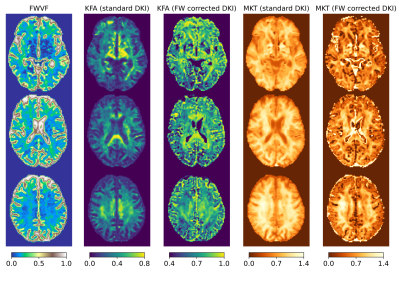 |
153 |
Free-water corrected Diffusion Kurtosis Imaging exhibits
modified age-related trajectories of the measures in the brain
white matter
Tomasz Pieciak1,
Guillem París1,
Dani Beck2,3,4,
Ivan I. Maximov3,5,
Antonio Tristán-Vega1,
Rodrigo de Luis-García1,
Lars T. Westlye2,3,6,
and Santiago Aja-Fernández1
1ETSI Telecomunicación, Universidad de Valladolid, Valladolid, Spain, 2Department of Psychology, University of Oslo, Oslo, Norway, 3NORMENT, Division of Mental Health and Addiction, Oslo University Hospital & Institute of Clinical Medicine, University of Oslo, Oslo, Norway, 4Department of Psychiatric Research, Diakonhjemmet Hospital, Oslo, Norway, 5Department of Health and Functioning, Western Norway University of Applied Sciences, Bergen, Norway, 6KG Jebsen Centre for Neurodevelopmental Disorders, University of Oslo, Oslo, Norway Keywords: White Matter, Diffusion/other diffusion imaging techniques Diffusion kurtosis imaging (DKI) allows quantifying Gaussian and non-Gaussian effects in diffusion MRI signal and has already proved its relevance, including assessing age-related brain alterations. Hitherto, the standard DKI follows a single-component signal representation with no explicitly defined free-water factor that might lead to a reduced specificity of tensor-based measures. This work demonstrates the free-water corrections to the DKI and revisits the variations in the metrics across the adult lifespan. Our study shows a significant reduction in variability and dynamics of the kurtosis fractional anisotropy and the preservation of the status quo in the mean kurtosis tensor with age. |
|
3032.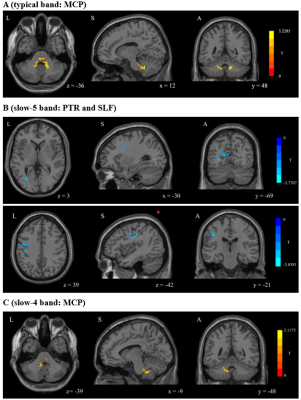 |
154 |
Desynchronized white matter function and structure in drug-naive
first-episode major depressive disorder patients
Qinger Guo1,
Jingfeng Duan2,
Shuyang Cai1,
Jiaxi Zhang3,
Tao Chen1,
and Hong Yang1
1Department of Radiology, The First Affiliated Hospital, College of Medicine, Zhejiang University, Hangzhou, China, 2Department of Psychiatry, The First Affiliated Hospital, College of Medicine, Zhejiang University, Hangzhou, China, 3Zhejiang Normal University, Jinhua, China Keywords: White Matter, Psychiatric Disorders Objective. To describe the abnormalities in WM function and structure in drug-naive first-episode MDD patients. Methods. 33 patients and 34 HCs were included. Different frequency bands of ALFF and FA were used to analyze the differences between the two groups. Results. Compared to HCs, patients showed decreased ALFF in PTR and SLF in slow-5 band, which were negatively correlated with the HAMD-17 anxiety/somatization factor items. No difference in FA between two groups. Conclusions. WM dysfunction relate to the pathophysiological mechanisms of MDD and predates structural damage. Compared to the typical and slow-4 bands, the slow-5 band is more sensitive for early detecting WM dysfunction. |
|
3033.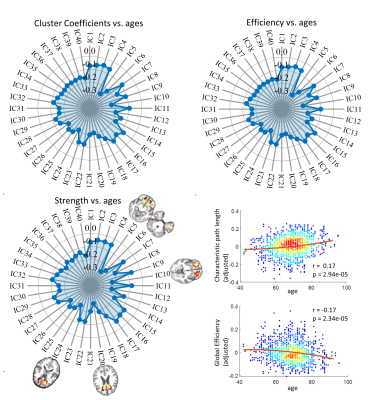 |
155 |
Aging-related Changes in Spontaneous Brain Activity in White
Matter
Muwei Li1,
Yurui Gao1,
Dylan R Lawless1,
Lyuan Xu1,
Yu Zhao1,
Kurt G schilling1,
Zhaohua Ding1,
Adam W Anderson1,
Bennett A Landman1,
and John C Gore1
1Vanderbilt University Institute of Imaging Science, Nashville, TN, United States Keywords: White Matter, Aging Recent studies have consistently reported that BOLD effects in WM reflect neural activities, and thus represent a new window into brain function. Here we evaluate the potential value of BOLD measurements in WM as an indicator of functional changes during normal aging. We observed a widespread reduction of metrics of WM BOLD effects, suggesting changes occur in information exchange in WM with aging. Our findings converge to support the notion that WM BOLD signals in specific regions and their interactions with others have the potential to serve as imaging markers of aging. |
|
3034.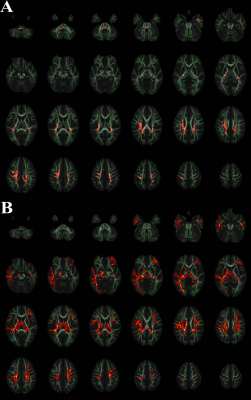 |
156 |
White matter abnormalities in pediatric idiopathic growth
hormone deficiency: A DTI study using TBSS analysis
Liuhui Wu1,
Huaqiong Qiu1,
Shu Su1,
Yingxi Chen1,
Long Qian2,
and Zhiyun Yang1
1Department of Radiology, The First Affiliated Hospital of Sun Yat-sen University, Guangzhou, China, 2GE Healthcare, Beijing, China Keywords: White Matter, Diffusion Tensor Imaging, Idiopathic growth hormone deficiency, TBSS Idiopathic growth hormone deficiency (IGHD) is an important and unknown causes of pediatric short stature. Although grey matter morphological changes in the cerebral cortex of IGHD have been proved, the knowledge about white matter (WM) is poorly investigated. Whether the mental status of IGHD children is associated with WM abnormalities is unclear. In this study, 50 pediatric with IGHD and 48 age- and gender-matched typically developing (TD) children included for TBSS analysis. Our results indicated that IGHD children showed the WM abnormalities (especially in bilateral posterior corona radiata), which are correlated with behavioral and mental problems. |
|
3035.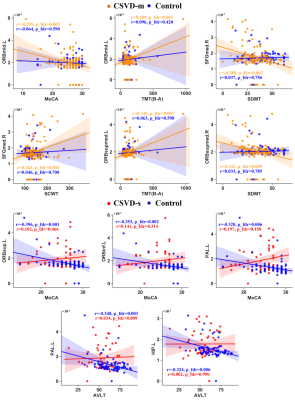 |
157 |
Increased Local Specialization of Structural Networks Revealed
by Probabilistic Diffusion Tractography in Cerebral Small Vessel
Disease
Mengmeng Feng1,
Wen Hongwei2,3,
Xin Haotian1,
Shengpei Wang4,5,
Chaofan Sui6,
Yian Gao6,
Changhu Liang1,6,
and Lingfei Guo1,6
1Shandong Provincial Hospital, Shandong University, Jinan, China, 2Key Laboratory of Cognition and Personality (Ministry of Education), Chongqing, China, 3School of Psychology, Southwest University, Chongqing, China, 4Research Center for Brain-inspired Intelligence, Institute of Automation, Chinese Academy of Sciences, Beijing, China, 5University of Chinese Academy of Sciences, Beijing, China, 6Shandong Provincial Hospital Affiliated to Shandong First Medical University, Jinan, China Keywords: White Matter, Diffusion Tensor Imaging We used probabilistic diffusion tractography and graph theory based on DTI to investigate the topologic organization of white matter (WM) structural networks in 54 patients with severe CSVD burden (CSVD-s), 117 patients with mild CSVD burden (CSVD-m) and 73 healthy controls. Compared with CSVD-m patients and controls, CSVD-s patients exhibited significantly increased local efficiency, normalized clustering coefficient and small world index, with partially reorganized hub distributions. In addition, the CSVD-s patients showed significantly increased nodal efficiency in some brain regions. Intriguingly, the significant correlation between node efficiency and cognitive parameters existed in CSVD-m and control groups. |
|
3036. |
158 |
Neural correlates of anxiety in rhesus macaques exposed to early
social adversity: A longitudinal DTI study across adolescence.
Hind Errame1,2,
Holly Rayson1,2,
Alice Massera1,2,
Yann Bihan-Poudec1,2,
Franck Lamberton3,
Mathilda Froesel1,2,
Maeva Gacoin1,2,
Suliann Ben Hamed1,2,
Nathalie Richard1,2,
Pier-Francesco Ferrari1,2,
and Bassem Hiba1,2
1Institut des sciences cognitives Marc Jeannerod (ISC) , CNRS, LYON, France, 2Claude Bernard University, Lyon 1, LYON, France, 3CERMEP - Centre d'Etude et de Recherche Multimodal Et Pluridisciplinaire en imagerie du vivant, LYON, France Keywords: White Matter, Diffusion Tensor Imaging Using diffusion tensor imaging (DTI) and behavioral observation, this study investigated the longitudinal effects of early social adversity (ESA) on risk for anxiety and the neural mechanisms underlying this relationship across adolescence. Diffusion MRI data were collected from 21 macaques comprising two groups that differed in exposure to ESA; mother-reared and nursery-reared. Each monkey was scanned at 2.5, 3.5 and 4.5 years old, with anxiety-like behavior assessed at each time-point. Results suggest that ESA has long-term effects on WM fractional anisotropy (FA) in several regions, with differences in frontolimbic and frontostriatal WM tracts modulating the relationship between ESA and anxiety . |
|
3037.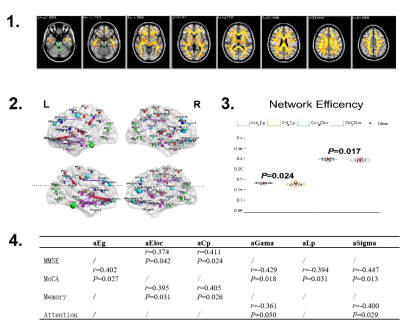 |
159 |
White matter integrity and structural connectivity disruption in
cognitive impairment T2DM patients with cerebral small vessel
disease
Huang ming ming1,
Yu Hui1,
Li Xiao Bao1,
Liu Jian Tao2,
Zhang Aaron3,
and Gao Bo4
1Department of Radiology, Affiliated Hospital of Guizhou Medical University, Guiyang, China, 2Philips Healthcare China, Xi an, China, 3Philips Healthcare China, Guangzhou, China, 4Affiliated Hospital of Guizhou Medical University, Guiyang, China Keywords: White Matter, Diffusion Tensor Imaging, type 2 diabetes mellitus DTI provides an effective way to investigate the white matter integrity and white matter connectivity. In this study, almost the white matter integrity was injured in cognitive impairment T2DM patients with CSVD , which were accompanied with reduction of FA value and increasing of λ∥、λ⊥ and ADC values . These results suggested that axonal injuries and demyelinating diseases maybe exist and induce the network connectivity disruption in these patients. More over, In patients with T2DM, network parameters were associated with memory and attention, significantly correlation were found between network parameters and cognitive assessment scores. These findings may provide new insights into how white matter abnormalities and white matter network disruption can affect cognitive function in patients with diabetes. |
|
The International Society for Magnetic Resonance in Medicine is accredited by the Accreditation Council for Continuing Medical Education to provide continuing medical education for physicians.